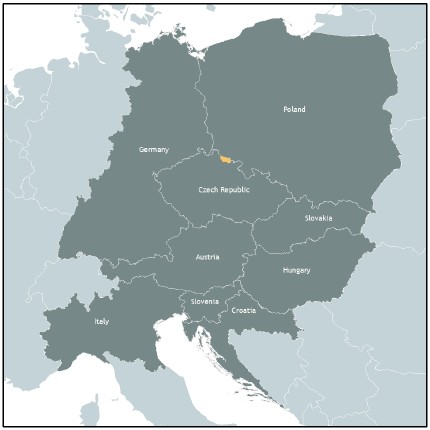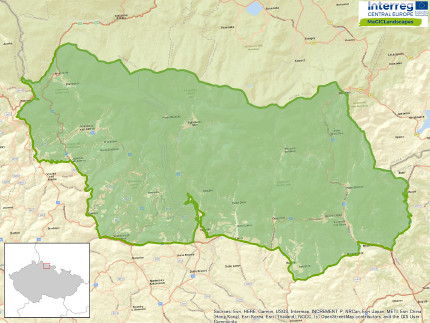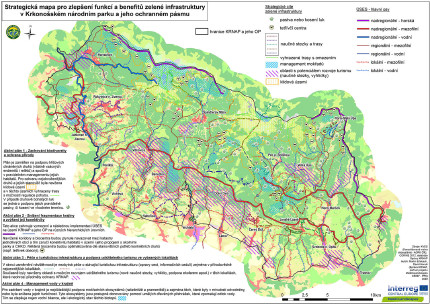Krkonoše National Park and surroundings
Green Infrastructure Strategy and Action Plan

|

Case study area Krkonoše National Park, Liberec Region and Hradec Králové Region, Czech Republic |
Description of the area
Krkonoše Mts. National Park (KRNAP) is oldest National Park in the Czech Republic. This mountainous, unique and valuable protected area encompasses a wide variety ecosystems and landscapes. Those landscapes include the lowlands of villages, fields and pastures, mountain mixed and spruce forests containing highly biodiverse meadows and arcto-alpine tundra characterised by natural grasslands with dwarf pine shrubs on the upper slopes and sparsely vegetated areas on the highest peaks.
The main purpose for the park’s designation is its geo-biodiversity, variability of the landscape and many species including those endemic to KRNAP such as the IUCN Red List Campanula bohemica and glacial relicts such as the Bluethroat (Luscinia svecica svecica). KRNAP has also been listed as a UNESCO Biosphere Reserve, Special Protection Area, and Site of Community Importance and is under the Ramsar Convention.
Issues
Despite the valuable biodiversity and many protected species, KRNAP has been declared by the IUCN as a one of the most endangered national parks. Air pollution was a significant issue in the past decades. Nowadays there are problems connected with development pressure (housing, hotels, ski centres), heavy tourism and climate change, with many valuable ecosystems and species exposed to the threat of drought. The advancing treeline is also increasing pressure on the fragile tundra ecosystem. Increasing tourism and the associated infrastructure (transportation, ski lifts and slopes etc.) have led to further landscape fragmentation and created barriers, reducing the ability of large mammals to move through the landscape.
Challenges
Krkonoše Mts. National Park faces a number of challenges. A key challenge lies in finding a common approach for all stakeholders (National Park and Protected areas Administrations, municipalities, etc.) in the park and its surroundings. Secondly it is necessary to improve connectivity and the functionality of green infrastructure in the whole region. The cross-border (Czech and Poland) location of the park means bilateral implementation and financing of mutual projects between municipalities, Parks Administrations and municipalities on both sides of the border is fundamental. Last but not least it still remains a challenge to persuade some stakeholders of the benefits of green infrastructure, especially those benefits which are not obvious to stakeholders or associated with their roles and responsibilities.
HOW THE STRATEGY WAS DEVELOPED
Outline of key themes, priorities and directions for the GI Strategy and Action Plan
Based on the previous stages and assessments the key themes and priorities of the green infrastructure strategy were identified. One of those key themes is Preserving Biodiversity and Nature Conservation to maintain the natural value of area and the various endemic and relic species. To fulfil this goal the management of key ecosystems and refuges will be necessary. In valuable arcto-alpine tundra ecosystem the park will fell the Pinus mugo shrubs (planted during last centuries) to support other protected floral and faunal species. The second planned action for this habitat is tourism management. During the nesting period in spring some selected trails will be closed and visitors will be directed to other tracks and locations. Additional measures such as projects that realise the renewal of grazing and appropriate mowing regimes will also ensure the perseverance of the mountain meadows and their biodiversity interest.
The second, though equally important, theme is landscape fragmentation and increasing connectivity. Krkonoše Mts. National Park is a one of the most visited protected areas in Europe, placing significant pressure on valuable ecosystems (i.e. arcto-alpine tundra) and is causing the fragmentation of protected key species habitats, such as those for Eurasian Lynx (Lynx lynx) and Black Grouse (Tetrao tetrix) for example. The KRNAP Administration are preparing (together with municipalities and district authorities) a new Territorial System of Ecological Stability to help migration for many species and for habitat creation. The creation of new black grouse habitats is another action to help reach this objective.
KRNAP provides many educational benefits, such as how nature and GI can help us and provide us with many services and benefits. Management of sustainable tourism based on field education is one way how we can protect the most valuable parts of the area. The construction of new education trails with views and other attractions and the reconstruction of current paths will support this objective.
Last, but not least, the themes connected with climate change and mitigation are a pressing issue and actions to water retention support were identified by all key stakeholders in the case study area. One key action to be undertaken is to address this is the building of small dams in aquatic ecosystems (springs, peat bogs). The list of the key benefits and priorities is shown in the table below.
GI Benefit | Strategic Tools/Policies | Partners | ||||
| Plán péče o Krkonošská národní park 2010 – 2020 (Zásady péče 2021 – 2040) | KRNAP Administration | ||||
| Tourism & recreation | Plán péče o Krkonošská národní park 2010 – 2020 (Zásady péče 2021 – 2040) Integrovaná strategie rozvoje regionu Krkonoše 2014 – 2020 (s výhledem do roku 2030) Strategie rozvoje Královéhradeckého a Libereckého kraje | KRNAP Administration Krkonoše – Alliance of towns and municipalities Municipalities Liberec and Hradec Králové Regional Authorities | ||||
| Water management | Plán péče o Krkonošská národní park 2010 – 2020 (Zásady péče 2021 – 2040) Strategie rozvoje Královéhradeckého a Libereckého kraje | KRNAP Administration Czech Ministry of the Environment Municipalities | ||||
| Health & well-being | Integrovaná strategie rozvoje regionu Krkonoše 2014 – 2020 (s výhledem do roku 2030) Strategie rozvoje Královéhradeckého a Libereckého kraje | KRNAP Administration Krkonoše – Alliance of towns and municipalities Municipalities Královéhradecký a Liberecký Region Authority Liberec and Hradec Králové Regional Authorities |
Key Players/actors in delivering the strategy and those that support its implementation
The selected goals of the Strategy have been incorporated into the fundamental strategic and statutory document of Krkonoše Mts. National Park - Plan for Maintaining the Krkonoše National Park 2021 – 2040. This is statutory document for all municipalities and other stakeholders in the case study area. The strategic plan for connectivity support (TSES) was adopted by the responsible authority of municipalities with extended powers (Trutnov, Jilemnice, Vrchlabí, Semily, Tanvald). Most of municipalities committed to implement TSES for habitat and landscape connectivity support into their territorial planning.
Expected benefits
By implementing the strategy the connectivity of landscape and habitats of key species will increase helping to preserve some threatened species through the defragmentation of the landscape. The landscape will become more resistant to drought and climate changes. Importantly the negative impacts of tourism and recreation will be reduced and the role of the park as an education resource will be enhanced.
Download the strategy (Czech language only)

GI Strategy Map of Krkonoše National Park
Contact
Krkonoše National Park Administration
Mgr. Martin Erlebach
merlebach(at)krnap.cz
www.krnap.cz
Header photo: KRNAP/Kamila Antošová
Back to WP3 OVERVIEW | CASE STUDY AREA | MAIN PAGE
